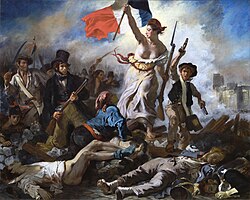
Back Amerikaanse Rewolusie Afrikaans الثورة الأمريكية Arabic Revolución Americana AST Amerika inqilabı Azerbaijani آمریکا اینقیلابی AZB Амэрыканская рэвалюцыя BE-TARASK Американска революция Bulgarian মার্কিন বিপ্লব Bengali/Bangla Američka revolucija BS Revolució Americana Catalan
| Part of the Atlantic Revolutions | |
 The Continental Union Flag (1775–1777) | |
 The Committee of Five presenting its draft of the Declaration of Independence to the Second Continental Congress in Philadelphia on June 28, 1776, depicted in John Trumbull's 1818 portrait, Declaration of Independence | |
| Date | 1765 to 1783 |
|---|---|
| Location | Thirteen Colonies (1765–1775) United Colonies (1775–1781) United States (1781–1783) |
| Outcome |
|
| Part of a series on the |
| American Revolution |
|---|
 |
|
|
| This article is part of a series on the |
| History of the United States |
|---|
 |
| Part of a series on |
| Revolution |
|---|
 |
|
|
The American Revolution (1765–1783) was a colonial rebellion and war of independence in which the Thirteen Colonies broke from British rule to form the United States of America. The revolutionary era reached its zenith with the American Revolutionary War, which commenced on April 19, 1775, with the Battles of Lexington and Concord. The leaders of the American Revolution were colonial separatists who, as British subjects, initially sought greater autonomy. However, they came to embrace the cause of full independence and the necessity of prevailing in the Revolutionary War to obtain it. The Second Continental Congress, which represented the colonies and convened in the present-day Independence Hall in Philadelphia, established the Continental Army and appointed George Washington as its commander-in-chief in June 1775. The following year, the Congress unanimously adopted the Declaration of Independence, which served to inspire, formalize, and escalate the war. Throughout the majority of the eight-year war, the outcome appeared to be uncertain. However, in 1781, a decisive victory by Washington and the Continental Army in the Siege of Yorktown led King George III and the British to negotiate the cessation of colonial rule and the acknowledgment of American independence. This was formalized in the Treaty of Paris in 1783, resulting in the establishment of the United States of America as a sovereign nation.
Discontent with colonial rule began shortly after the defeat of France in the French and Indian War in 1763. Even though the colonies had fought in and supported the war, British Parliament imposed new taxes to compensate for wartime costs and transferred control of the colonies' western lands to British officials in Montreal. Representatives from several colonies convened the Stamp Act Congress in 1765; its "Declaration of Rights and Grievances" argued that taxation without representation violated their rights as Englishmen. In 1767, tensions flared again following British Parliament's passage of the Townshend Acts. In an effort to quell the mounting rebellion, King George III deployed British troops to Boston, where British troops killed protesters in the Boston Massacre on March 5, 1770. In 1772, anti-tax demonstrators destroyed the Royal Navy customs schooner Gaspee off present-day Warwick, Rhode Island. On December 16, 1773, in a seminal event in the American Revolution's escalation, Sons of Liberty activists wearing costumes of Native Americans instigated the Boston Tea Party, during which they boarded and dumped chests of tea owned by the British East India Company into Boston Harbor. London responded by closing Boston Harbor and enacting a series of punitive laws, which effectively ended self-government in Massachusetts but also served to expand and intensify the revolutionary cause.
In late 1774, 12 of the Thirteen Colonies sent delegates to the First Continental Congress, which met inside Carpenters' Hall in Philadelphia; the Province of Georgia joined in 1775. The First Continental Congress began coordinating Patriot resistance through underground networks of committees. Following the Battles of Lexington and Concord, Continental Army surrounded Boston, forcing the British to withdraw by sea in March 1776, and leaving Patriots in control in every colony. In August 1775, King George III proclaimed Massachusetts to be in a state of open defiance and rebellion.
In 1776, the Second Continental Congress began debating and deliberating on the Articles of Confederation, an effort to establish a self-governing rule of law in the Thirteen Colonies. On July 2, they passed the Lee Resolution, affirming their support for national independence, and on July 4, 1776, they unanimously adopted the Declaration of Independence, authored primarily by Thomas Jefferson, which embodied the political philosophies of liberalism and republicanism, rejected monarchy and aristocracy, and famously proclaimed that "all men are created equal".
The Revolutionary War continued for another five years during which France ultimately entered the war, supporting the colonial cause of independence. On September 28, 1781, Washington, with support from Marquis de Lafayette, the French Army, and French Navy, led the Continental Army's most decisive victory, capturing roughly 7,500 British troops led by British general Charles Cornwallis during the Siege of Yorktown, leading to the collapse of King George's control of Parliament and consensus in Parliament that the war should be ended on American terms. On September 3, 1783, the British signed the Treaty of Paris, ceding to the new nation nearly all the territory east of the Mississippi River and south of the Great Lakes. About 60,000 Loyalists migrated to other British territories in Canada and elsewhere, but the great majority remained in the United States. With its victory in the American Revolution, the United States became the first large-scale modern nation to establish a federal constitutional republic based on a written constitution, extending the principles of consent of the governed and the rule of law over a continental territory, albeit with the significant democratic limitations typical of the era.